It’ll take 16 more images to tell the rest of the story that I started yesterday but I thought it was worth telling.
Two days ago I took 441 photos of a cooperative male American Kestrel on three different perches at Farmington Bay WMA during a 19 minute session. During most of that time he had a very large vole in his clutches and that prey item made the encounter particularly interesting. Due to time constraints I only posted a single photo of him yesterday but I promised that more would soon follow.
This edition of Feathered Photography fulfills that pledge. All photos are presented in the order they were taken.
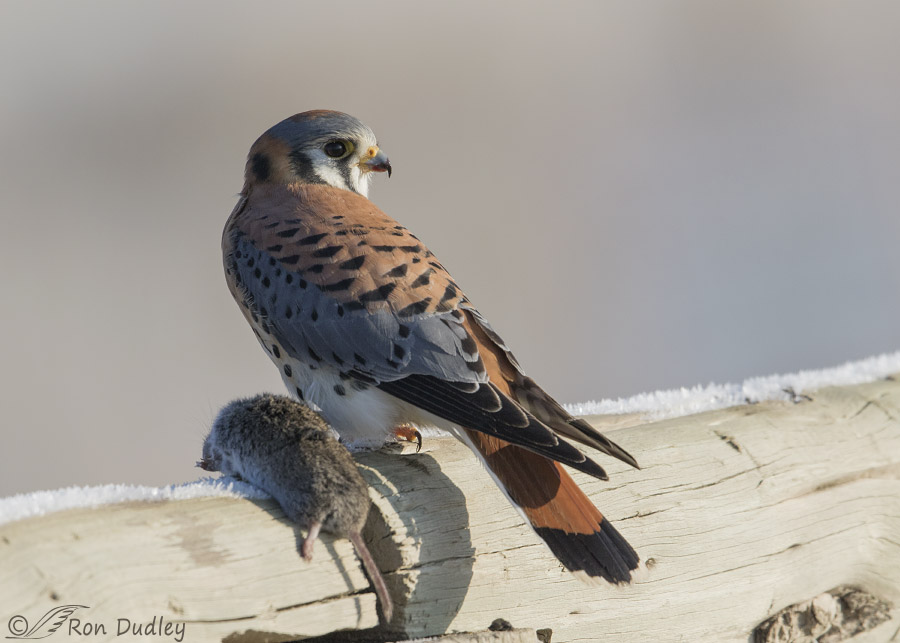
1/1600, f/7.1, ISO 640, Canon 7D Mark II, Canon EF 500mm f/4L IS II USM + EF 1.4 III Extender, not baited, set up or called in
When I first encountered the kestrel he was perched on a wooden fence railing very close to the edge of the road but he was strongly sidelit so I had to significantly tweak this image during processing to make it look even this good. Immediately before this shot was taken the falcon administered the coup de grâce to the vole by biting its neck. Typically they use their “falcon tooth” (tomial tooth) on their bill to sever the spinal cord and I assume that’s what happened here.
I only had a few seconds with the bird on this perch because a very noisy vehicle came by on the washboardy dirt road and scared him off.
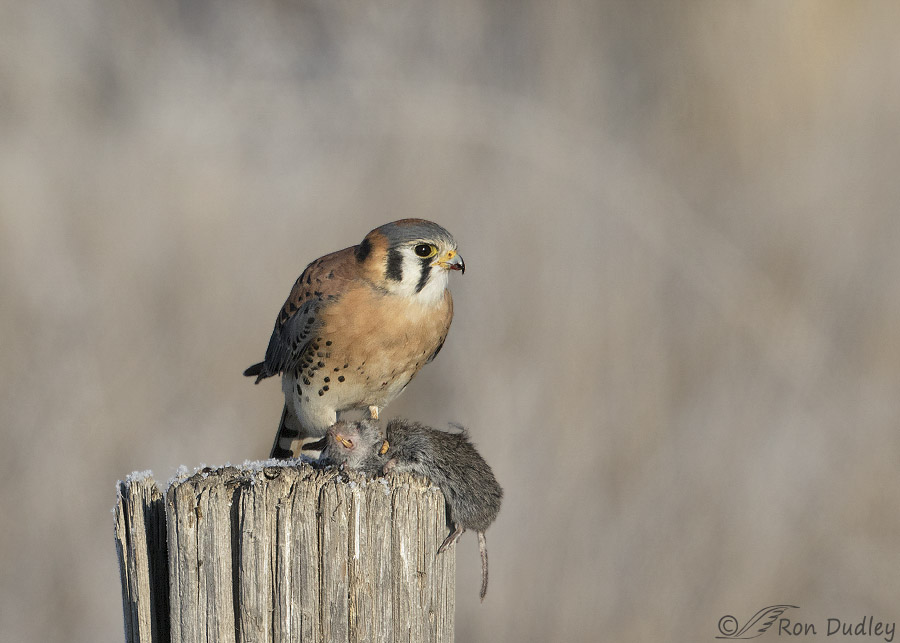
1/4000, f/7.1, ISO 640, Canon 7D Mark II, Canon EF 500mm f/4L IS II USM + EF 1.4 III Extender, not baited, set up or called in
But he didn’t go far. He flew across a small creek next to the road and landed on this post with the vole. Thankfully he was in good light and still at a reasonable distance from me so I was able to get many interesting photos and he was perfectly comfortable with my presence at that distance.
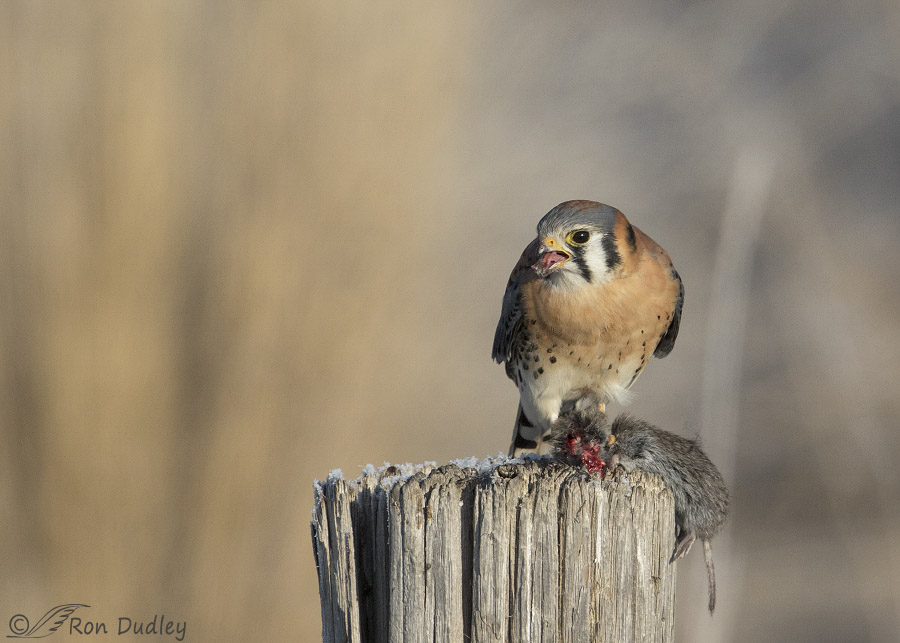
1/5000, f/7.1, ISO 640, Canon 7D Mark II, Canon EF 500mm f/4L IS II USM + EF 1.4 III Extender, not baited, set up or called in
He started his meal at the head of the vole and I expected to spend a lot of time with him as he consumed the entire rodent. But looking at these early photos I can see that his crop was already bulging so that isn’t what happened.
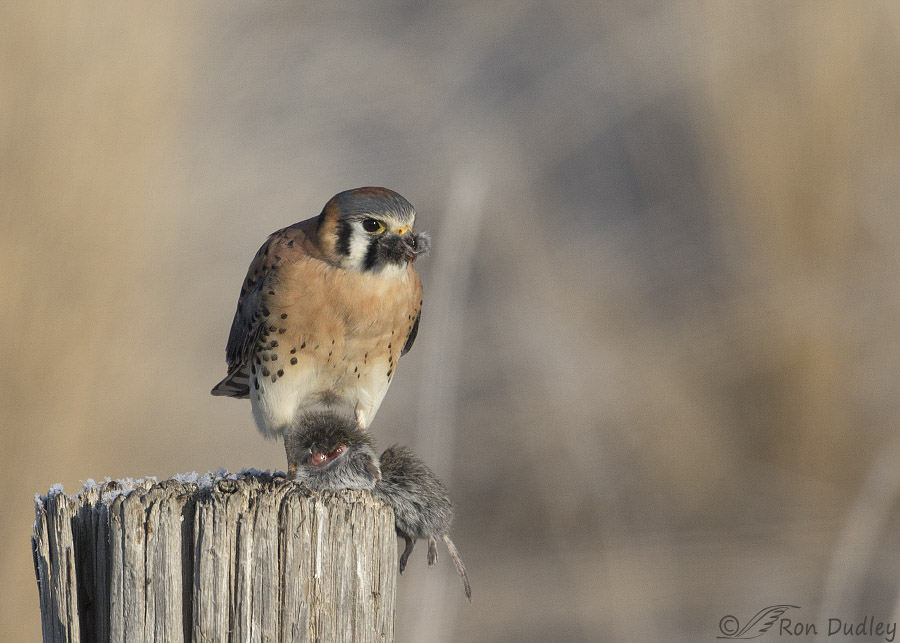
1/5000, f/7.1, ISO 640, Canon 7D Mark II, Canon EF 500mm f/4L IS II USM + EF 1.4 III Extender, not baited, set up or called in
Several times he swallowed huge clumps of what appeared to be nothing but hair which made him look pretty silly. Perhaps he filled up mostly on “fluff”.
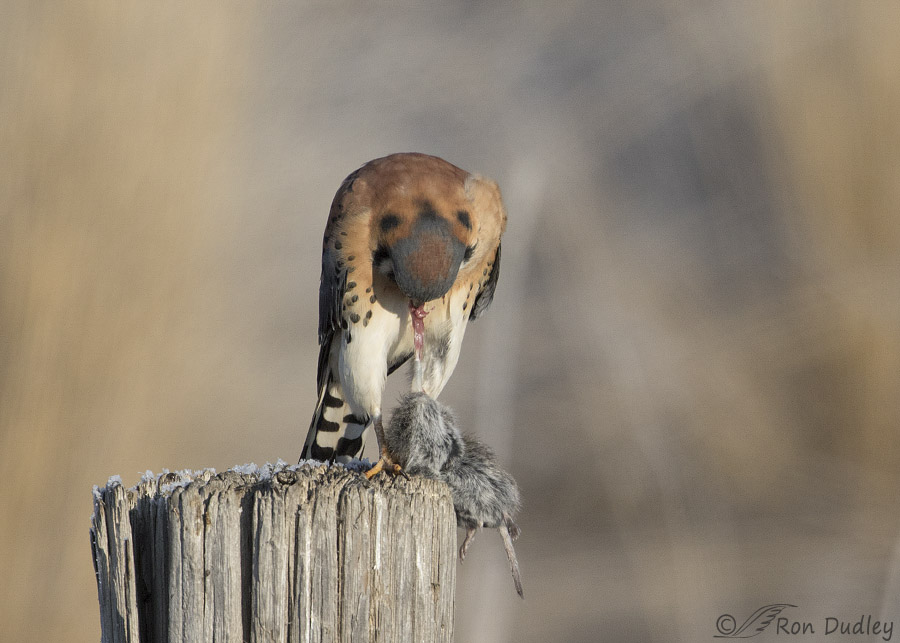
1/4000, f/7.1, ISO 640, Canon 7D Mark II, Canon EF 500mm f/4L IS II USM + EF 1.4 III Extender, not baited, set up or called in
But he got some protein in the mix even if he did have to work hard for it.
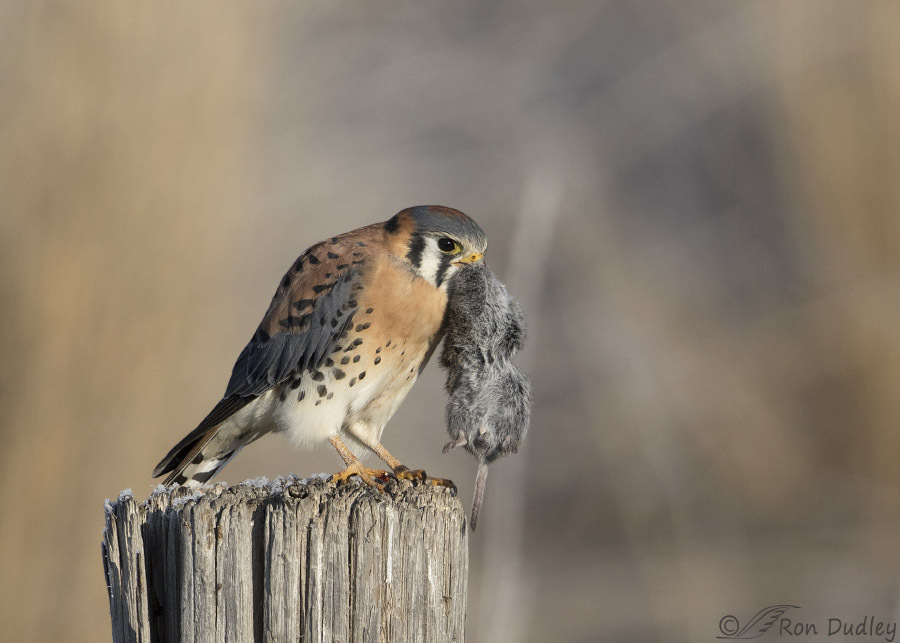
1/5000, f/7.1, ISO 640, Canon 7D Mark II, Canon EF 500mm f/4L IS II USM + EF 1.4 III Extender, not baited, set up or called in
But it wasn’t long before he stopped eating. He picked up the (huge) vole in his beak and then almost immediately…
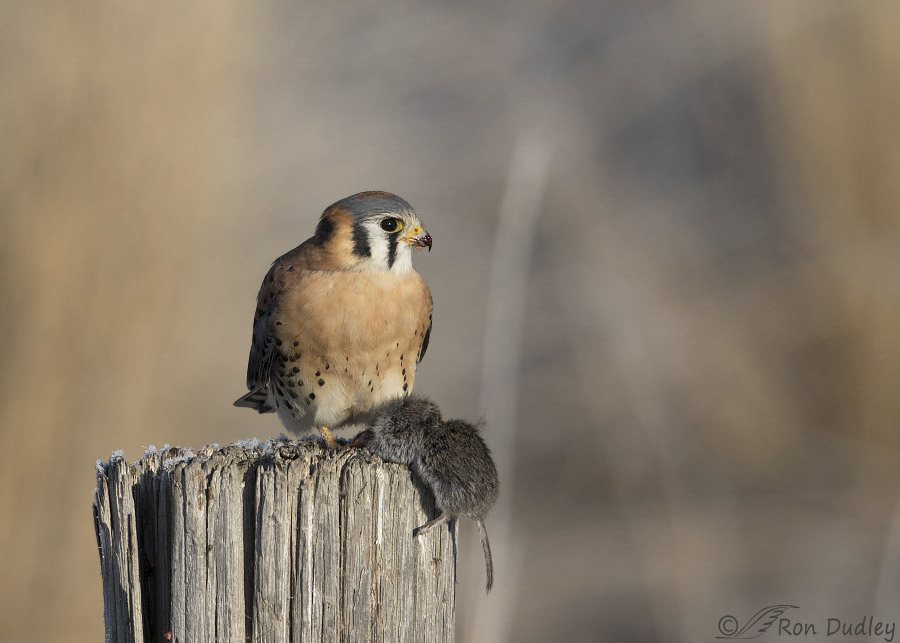
1/5000, f/7.1, ISO 640, Canon 7D Mark II, Canon EF 500mm f/4L IS II USM + EF 1.4 III Extender, not baited, set up or called in
transferred it to his left foot. And then he just stood there with his bloody beak and looked first to his left and then to his right as if he was trying to make a decision as to which way to go when he took off with the vole. In retrospect I’m convinced that at this point his appetite was already satiated and his intention was to cache the vole for a future meal.
I believe he was trying to decide where to stash it.
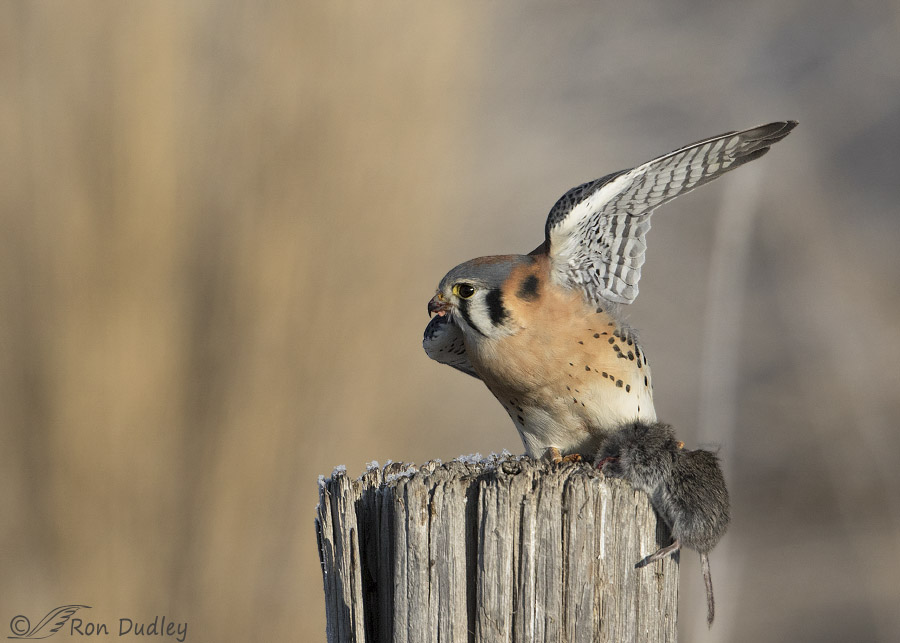
1/5000, f/7.1, ISO 640, Canon 7D Mark II, Canon EF 500mm f/4L IS II USM + EF 1.4 III Extender, not baited, set up or called in
For some reason his first takeoff was aborted. I got three images as he began to raise his wings…
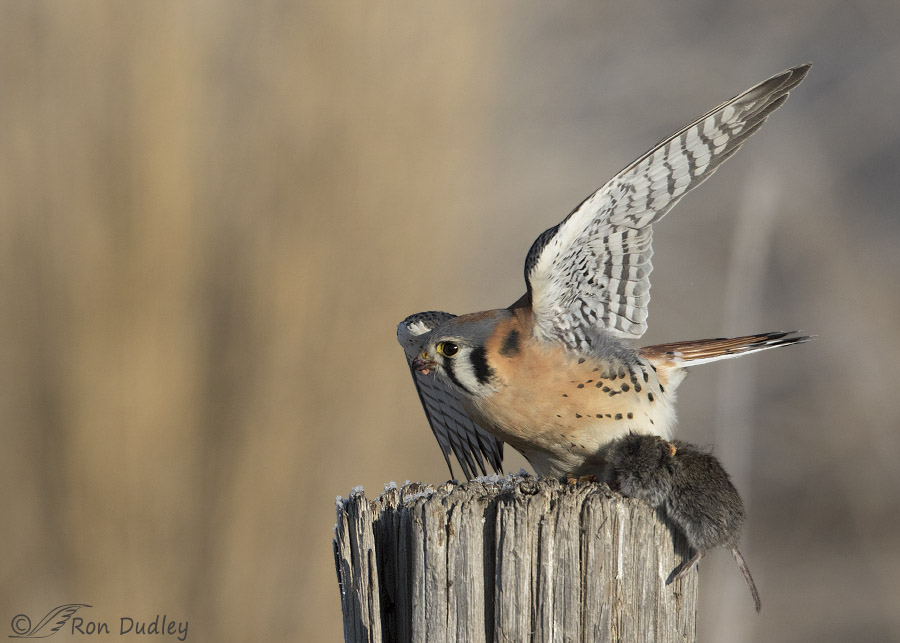
1/5000, f/7.1, ISO 640, Canon 7D Mark II, Canon EF 500mm f/4L IS II USM + EF 1.4 III Extender, not baited, set up or called in
and crouch to push off to his right…
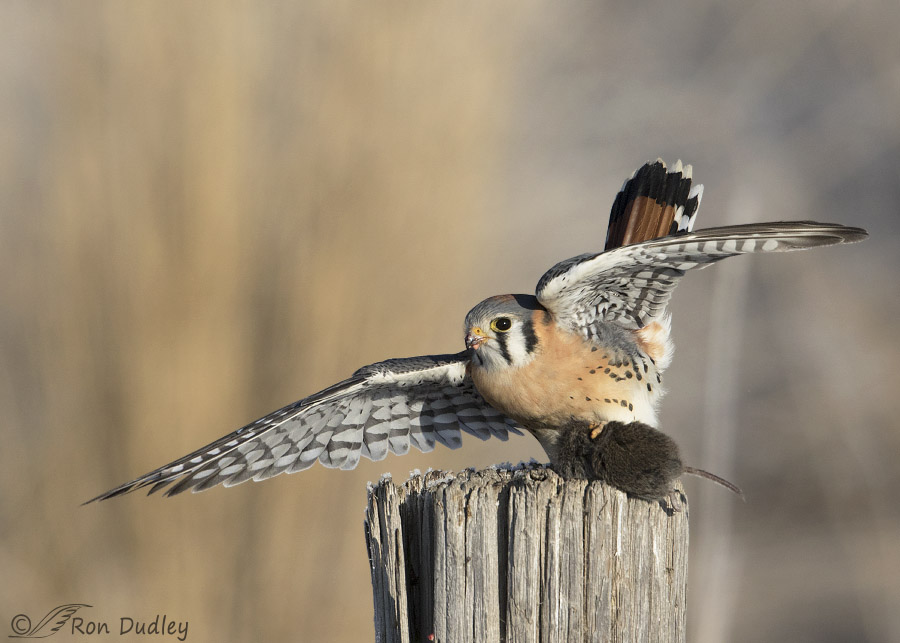
1/5000, f/7.1, ISO 640, Canon 7D Mark II, Canon EF 500mm f/4L IS II USM + EF 1.4 III Extender, not baited, set up or called in
but then he caught himself at the last millisecond (this is the image I posted yesterday) and…
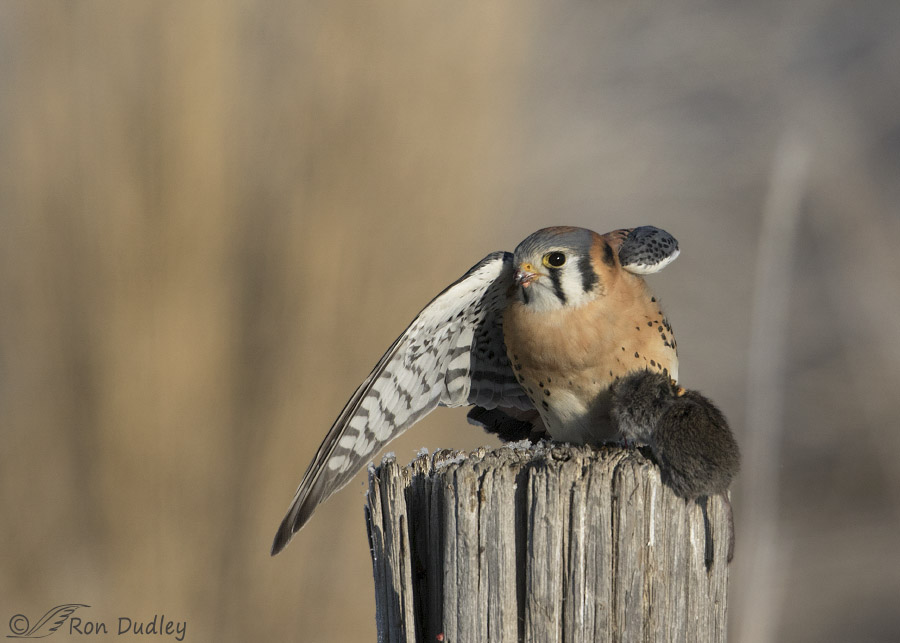
1/5000, f/7.1, ISO 640, Canon 7D Mark II, Canon EF 500mm f/4L IS II USM + EF 1.4 III Extender, not baited, set up or called in
began to fold his wings again…
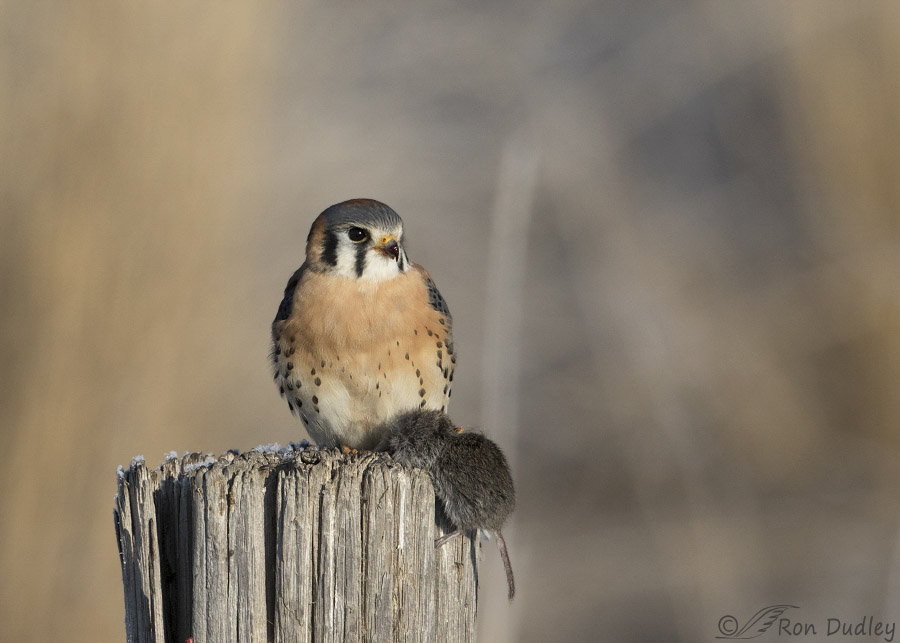
1/5000, f/7.1, ISO 640, Canon 7D Mark II, Canon EF 500mm f/4L IS II USM + EF 1.4 III Extender, not baited, set up or called in
and stayed on the perch to look around some more.
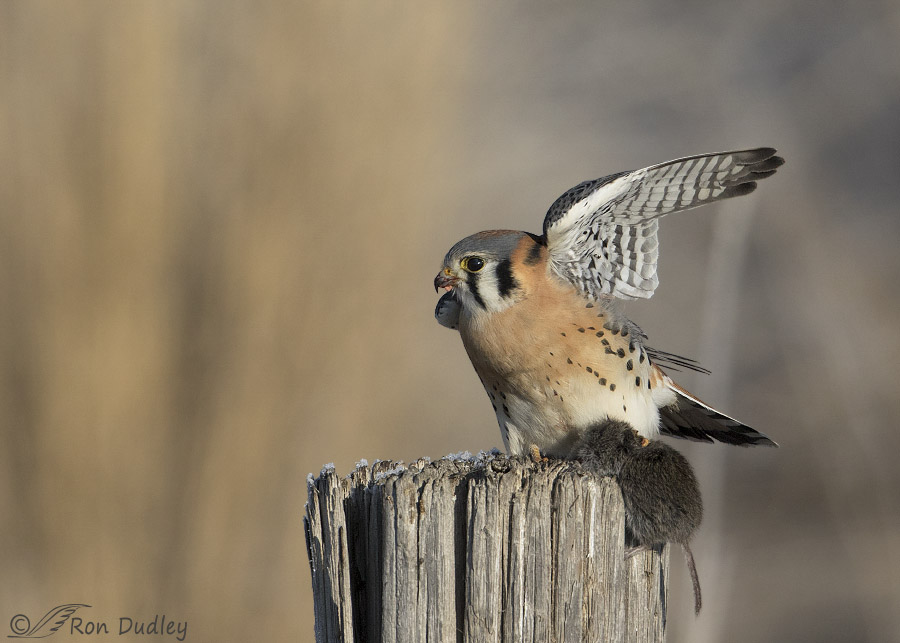
1/5000, f/7.1, ISO 640, Canon 7D Mark II, Canon EF 500mm f/4L IS II USM + EF 1.4 III Extender, not baited, set up or called in
But eventually he did take off in the same direction as he attempted previously.
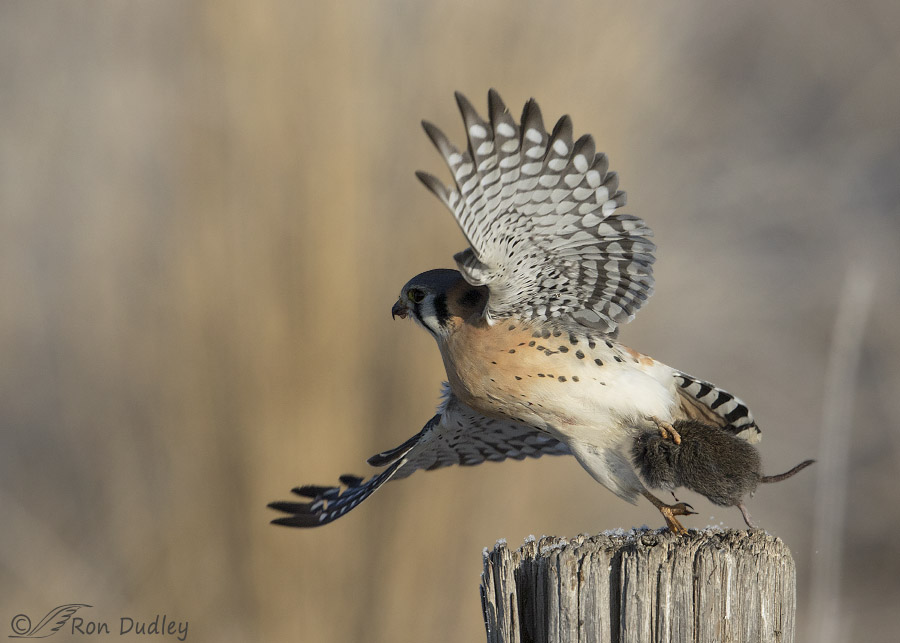
1/5000, f/7.1, ISO 640, Canon 7D Mark II, Canon EF 500mm f/4L IS II USM + EF 1.4 III Extender, not baited, set up or called in
But dammit his left wing shaded his head…
1/5000, f/7.1, ISO 640, Canon 7D Mark II, Canon EF 500mm f/4L IS II USM + EF 1.4 III Extender, not baited, set up or called in
in both shots I got of the takeoff. That was a real piss-me-off for me because I’d love to have been able to get nice takeoff and flight shots with the vole in his talons. Maybe next time.
From here he flew to the side of Goose Egg Hill where he landed in the snow near a rock. I’m convinced he cached the vole near that rock because almost immediately…
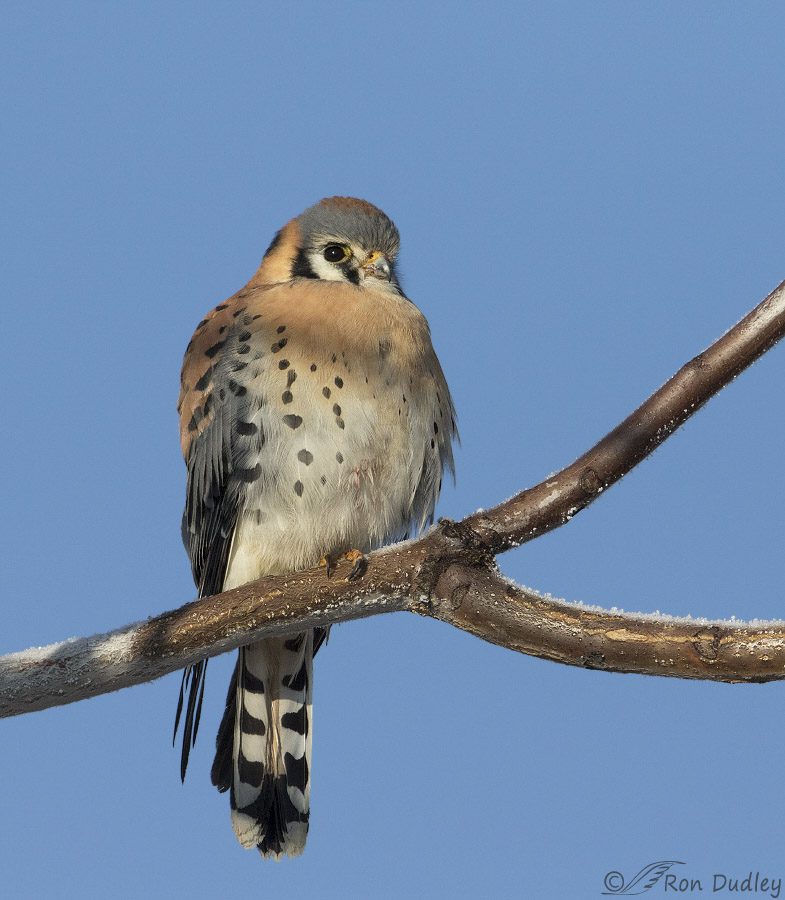
1/4000, f/7.1, ISO 640, Canon 7D Mark II, Canon EF 500mm f/4L IS II USM + EF 1.4 III Extender, not baited, set up or called in
he landed in a tree on the side of the hill sans vole (yes, there’s a shadow of a branch across his chest).
That vole was (or will be) likely frozen solid when he retrieves it for another meal. I’ve photographed kestrels eating cached and frozen “volecicles” in the past and it’s hilarious to watch them attempt to pull chunks off of their frozen rodent.
I’d love to do it again.
Ron


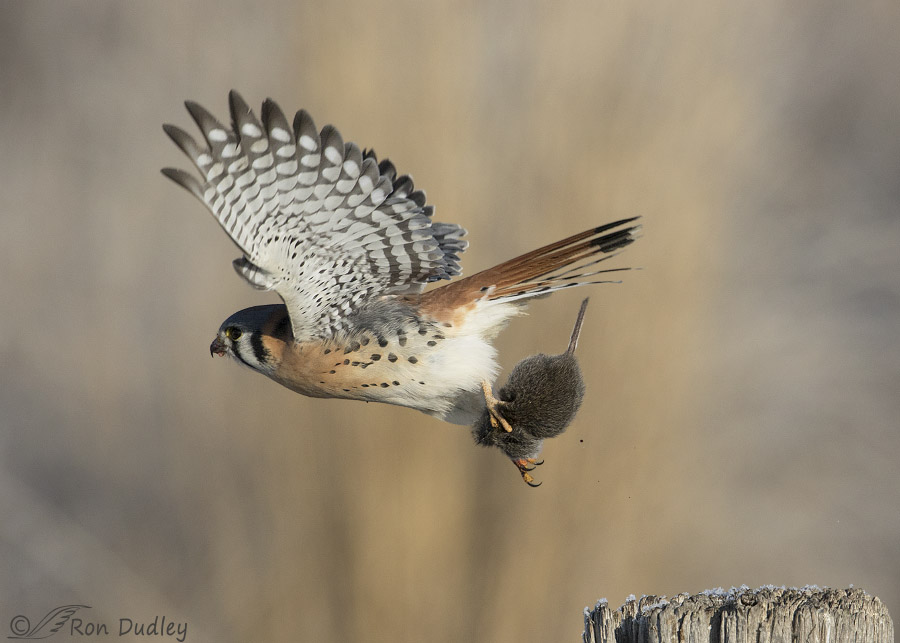
Stunning, again! You, being a happy photographer, make us happy viewers. Thank you!
Neat story and great images Ron. Early on in the narrative I was getting full myself just looking at how big that meal for the kestrel was and wondering how he would consume it all. I guess I have never seen a kestrel cache food, although it makes perfect sense. In the past doing Boreal Owl research I was surprised to learn that they fill up their cavity with frozen red backed voles and freeze them, thawing them out later on for consumption. Impressive! Thanks for the education and awesome sequence of photos.
Thanks, Ed. I’ve seen kestrels retrieve and consume cached food (always voles in my experience) several times but it’s always been during frigid times of winter and the vole has always been frozen. I’ve also seen and photographed the same behavior with a Merlin but only once and in that case the prey item was a frozen meadowlark.
Gotta admit to some curiosity about how those owls you mention thaw out their food. Microwave…?
Late to the party, Ron, but what a stunning series! I know the shadow of the perch across his chest drives you nuts, but it doesn’t bother me at all. In some way it helps to draw my eyes down to the tiny bit of blood on his abdominal feathers. And the frost on the perch is just icing on the cake!
I’ve seen worse shadows on birds, Diane but I still don’t like it much. I agree about the frost.
Many of us adults, have, um, a stash of nice dark chocolate (mine is in the t-shirt drawer) and I feel kinship with this lovely creature – look left, look right – is that a kid I hear, coming down the hallway? Quick! Hide the chocolates!!
You made me smile, Nicole, big time. Yes, there’s many reasons to be furtive about your stash!
Thanks for that laugh, and yes, I too have a guarded stash of goodies!
What a fantastic series, Ron! I love seeing yesterday’s shot in context. That is one big vole! Your shots are so clear too (even with the picked nits) — easy to see the vole’s teeth, the blood on the kestrel’s beak and chest, and each feather and strand of fur. The last shot shows one self-satisfied bird!
Thanks for noticing the sharpness and detail of the images, Marty. I thought both were pretty good considering my distance from the kestrel.
I have just discovered your very informative and entertaining blog. Thank you. I am out in the Cosumnes Nature Preserve/Sacramento area practicing my winter bird migration shots. Just curious…..are you shooting from your car or afoot? Thank you so much for your camera settings. I find it helpful to compare mine with yours. I use a Nikon 7100 with a 150-600mm lens. How does this compare with your Canon 500 with extender for getting close shots? Thank you again for sharing your talent and wisdom.
Welcome to Feathered Photography, Jacquie.
I’m nearly always shooting from my pickup. When I’m using a tripod I usually include it in my image techs under my images.
With the crop factor of my camera I’m shooting at an effective 1120 mm with my tc attached (as it nearly always is). I’m generally unfamiliar with Nikon so I don’t know what the crop factor of your D 7100 is.
Hard to believe that such a small bird could lift…and fly…with such a big, fat vole….
Yup.
With a crop that full it would take me a while to work up the energy for take-off too. And I would have to cache the megavole for later meals.
Another brilliant series. Thank you.
Me too. Thank you, EC.
Great photos, and I learned something new, as usual when I read your blog (was not aware of the tomial tooth). Many thanks!
Nancy, that tomial tooth comes in very handy for falcons and species like shrikes. Glad to hear you learned something here today!
“Maybe next time.”? Always looking to bat 1,000, but grateful for what we get and the time spent with feathers.
Nice work!
“Always looking to bat 1,000”
Made me smile, Neil. Yup, that’s me but of course I never actually expect too. Actually I’d be very happy with a photographic batting average of .1500 since I usually delete about 90% of my images.
Beautiful and fun series of photos. I love the lighting and the background colors match the kestrel colors. Birds tend to imitate their habitat in coloration, your photos are a good example. I still can’t get over the size of the vole in comparison to the kestrel.
I agree about that vole, April. I don’t think I’ve ever seen a larger one.
Ron:
I have been following your blog daily for about a year now and I very much enjoy it. I also come from farming roots in the Northwest and now live in Utah so I can relate well with a lot of what you have to say. I now live above Farmington Bay in Davis County and have often wondered as I head off to work if you are out there “shooting” birds during those early morning hours. I have tried to photograph Kestrels when I have gone down near Farmington Bay but my photographing skills are pretty poor. They really are an amazing bird – probably one of my favorites as also stated by an earlier poster. Thank you for telling a good story along with your photos. Have you considered posting on Instagram? I have looked for you there but have not found you. I think many of the nature photographers who post on Instagram have a lot of influence for good and your presence there could contribute even more to that good influence. Anyway, just a thought if you are not already there.
No, I’ve never considered being active on Instagram, Brad. I barely have time for shooting, culling, my blog and Facebook as it is. But I’ll admit that your suggestion got my curiosity going about Instagram a little so I guess I’ll have to check it out.
I’m curious. Are you related to the late Ward Roylance, the well-known environmental writer out of Torrey, Utah? I used to read a lot of his work,
Ward is a distant cousin. He wrote our family history called “Roylance Family of Western America” (which I have in a prominent place in my home and which I reference often). I met with him one time down in Torrey in his grand teepee like lodge. I would have liked to have known him better and have him show me around Southern Utah; which I understand he was always very willing to do. But, he died while I was still in school at the U and as poor as a church mouse. I imagine the events of this past year in Southern Utah regarding public lands had him turning over in his grave.
Re Instagram, for photography purposes, I much prefer Instagram over Facebook. Instagram seems to me to be set up perfectly for presentation of photos (and really not much else).
Ward was a pioneer in his field and I’d be proud if I were related to him – just as you seem to be.
I guess one of the reasons I never investigated Instagram is because I assumed it was limited to posting photos there directly instead of posting links to blog posts like I do on FB. I’ll have to check it out to see if that’s true.
Spectacular series, Ron. Love the Kestrals and their “can-do” attitude…
Thank you, Dan. Me too!
Absolutely Awesome behavioral series Ron!!!
Charlotte
Thank you, Charlotte.
Beautiful series !! I somehow continue to miss the shot of them flying with voles … I have to be contend with them feasting ..
Getting them in flight with prey isn’t easy, Marina. They’re just too small and fast!
As usual, what a wonderful series of one of my hands-down favorite birds! Male Kestrels are so darn beautiful and you’ve captured a slice of this one’s life in exquisite detail.
I’m also delighted that you’re “a happy bird photographer,” all your perceived nits aside. I’m certainly a happy girl seeing this series first thing this morning! I could have posted this much earlier, but a) I was awakened to my Brittany throwing up only to find that he had been throwing up for a while, circling the bedroom with little puddles of wet stuff and b) I lingered over each photo for a while, slurping up its beauty as I cleaned up the mess
Laura, I’m always happy when I can get at least one shot I like and I like that one I posted yesterday very much.
I figured you might enjoy this post!
I have very fond memories of a male Kestrel I flew for two years in Dallas. We lived where every starling in the world roosted in White Rock Lake Park, then came into the neighborhood to forage on the morning rush hour and again on the evening rush hour before they headed back to their roost. We had BIG fun together, unlike this female who is responsible for my early baldness! I just cannot get her interested in chasing real prey–she prefers dinner delivered on time, thank you very much. But that male, Sneaker, was lethal on starlings and sparrows. He even caught a big (for him) grackle! I loved that boy! Broke my heart when a Cooper’s hawk got him. Sigh…
Wonderful series Ron, great post!
With all our grandiose idea of our intellagence it is amazing how similar we are to regular, regardless of Phylum, animal behavior. It should make us very humble!! But, of course, present day action and reaction shows that doesn’t equate.
We are in for a nasty storm, snow is just beginning for us, but family is in the thick of it along the coast.
Many thanks for sharing.
Thanks, Dick. Good luck to you and your family with that storm It looks like it’s going to be a doozy.
Do all falcons/hawks cache prey or is it breed specific?
Jo, I don’t know if they all cache prey but many do.
For a wild creature, having a full belly, full crop, and a full “refrigerator” must present an unusual situation ! If he/she isn’t actively seeking a mate, tending a family, or migrating, what ELSE is there for a bird
to do ? I don’t wonder that there were several aborted takeoffs…….I always think of their cruising the skies as beautiful sight-seeing, but of course it isn’t– I imagine that their
instincts disallow frivolous expenditure of calories………but crows and ravens seem to be joy-riders just for the hell of it–I wonder how they can “afford” it, when most birds can’t ?
“If he/she isn’t actively seeking a mate”
Kris, a couple of days ago I was surprised to see a pair of kestrels apparently pairing up already. They were together on a tree and one of them was actually on top of a nest of another species for some reason.
The kestrel’s aborted takeoff reminds me of when I drive out and forget my wallet, then remember it just before pulling out into the street! The clarity of your images and of the accompanying narrative are most enjoyable!
Ha, that aborted takeoff reminds me of when I leave my house in the dark in the morning to go shooting and make it half way up the street before I wonder if my garage door completely closed as I left. I hit my brakes and back up in the dark to make sure it did.
Can’t tell you how many times that’s happened! Thank you, Ken.
I’m glad I’m not the only one who has to “abort takeoff” and go back to check on something.
Don’t feel like the Lone Ranger!
LOL Ken! It’s a rare event when I get to leave the house on the first try. Thanks for that laugh this morning!
And Ron, the whole garage door thing baffles me. I load the Jeep for the day’s hunting through the garage, and by the time I get in the Jeep to head out, the garage door is pretty much the LAST thing on my mind. Instead, I’ve got visions of pesky wabbits on my mind. So many times I come home to an open garage door, all my old magazines (that contain stories I’ve written in the past), decades-old VCR recordings of races long past, and other stuff I haven’t yet unpacked, offered free to the world! Nobody’s taken me up on that offer yet. Not sure if that’s a good thing, or not.
Wonderful series, Ron! His crop definitely indicated he’d have trouble stuffing any more in – hopefully something else doesn’t find his “stash” before he does…………:) You didn’t “win them all” on the shots as far as technical excellence, BUT you did document his meal VERY well in my opinion and some shots are great!
His crop definitely indicated he’d have trouble stuffing any more in – hopefully something else doesn’t find his “stash” before he does…………:) You didn’t “win them all” on the shots as far as technical excellence, BUT you did document his meal VERY well in my opinion and some shots are great!  Made +45 yesterday with minimal wind so snow got “settled” a lot – YES! +21 this morning.
Made +45 yesterday with minimal wind so snow got “settled” a lot – YES! +21 this morning.
You’re right, Judy. I never “win them all” but I’m happy to get a few I like and I adore that shot I posted yesterday so I’m a happy bird photographer. And just the experience of watching this behavior for so long was very rewarding.